CommunicationCommunication is defined as the act of expressing our views to others through the use of signs, expressions, symbols, spoken words, or any activity to reach a common understanding. We can communicate with a person or a group of persons. It is also defined as exchanging information through writing, speaking, or any other medium. It is the successful transfer of views and feelings. Let's consider the below examples.
Communication depends on mutual understanding between people. It means we can communicate if the other person or a group can understand the same language. We know that English is a global language. Due to this, we can easily communicate with various people all over the world. 
The improper communication lacks in a mutual understanding. A deaf person cannot hear the spoken words. Similarly, a blind person cannot understand the sign and symbols. Hence, communication plays a vital role in our life. Today we can also communicate sitting at long distances using mobile phones. We can either communicate using a direct phone call or face to face using video calls. It has made the communication process even more comfortable. A person with high-qualification is incomplete without proper communication skills. Here, we will discuss the following topics:
Communication Process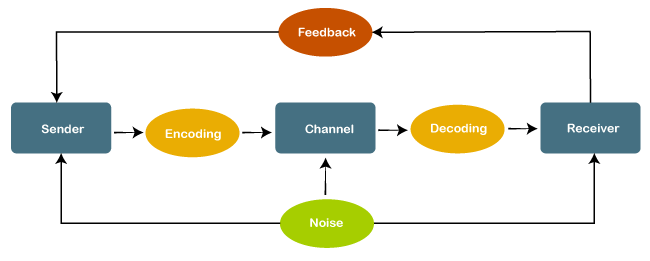
The communication process for all types of communication can be categorized into four parts, which are listed below:
SenderThe sender can present his/her views in the form of verbal or non-verbal communication to the recipient in the understandable form. The sender encodes the message in the form of written text, speech, digital data, gestures, pictures, etc. A message from the sender is sent to a receiver or multiple receivers. A sender can also seek feedback from the receiver to confirm that the message has been understood without any misunderstanding or confusion. Sometimes, different techniques are also used by the receivers, which ensure the correct interpretation of the message. Channel of CommunicationThe encoded message as a sequence of signals is transmitted through the channel or medium. Some natural forces, such as noise sources, human activities, can cause interference in the signal, which can degrade the quality of signals reaching the receiver. Today, we can easily convey our message to others using different means of communication, such as text messages, telephone conversations, video conferences, emails, face-to-face conversations, letters, magazines, newspapers, radio, television, and social media Internet. Each channel has its advantages and disadvantages. For example,
Hence, the selection of the correct channel determines effective communication. ReceiverThe encoded message is assembled on the receiver side, which is known as decoding. The received message is the correct interpretation of the original signal. The decoding of the message depends on how the receiver feels at the time of the received message. Sometimes, barriers or obstacles in communication can also affect it. The understanding between the sender and the receiver also helps correct the message with reduced or minimum misunderstandings. For example, If the sender knows the receiver, he/she will send the message according to the receiver's understanding, which helps in the correct decoding of the received message. FeedbackIt is the final part where the receiver gives the feedback to the sender for the received message. The receiver can use any communication, such as verbal, non-verbal, visualization, or written, to provide feedback on the correct understanding of the message. It is useful to correct the confusion between the sender and the receiver. The feedback for face-to-face communication will be immediate, while in the case of written communication (online mode), it can be delayed depending on the receiver. Effective communication or successful communication is verified through the feedback because it is the only way to check whether the receiver has correctly understood the message. Scientific CommunicationThe scientific study of communication can be categorized as:
Types of Communication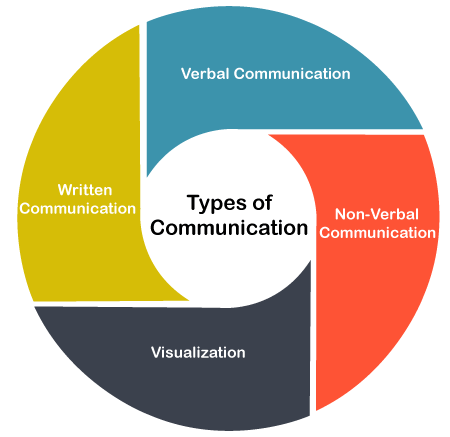
There are two types of communication, which are listed below:
Let's discuss this in detail. Verbal CommunicationVerbal communication is defined as the act of presenting the views to others in the form of words or sounds. The series of words and grammar rules define the language. Human language is different for users around the world. Every country has its national language, where English is considered as a global language. Communication through radio, television, or mobile phones is also called verbal communication. Two or more than two persons can quickly communicate if they are aware of their languages. It might be difficult for people to communicate with the knowledge of different languages. For effective communication, there must be a common language, which everyone present can understand. Non-Verbal CommunicationNon-verbal communication is defined as presenting the views to others in the form of eye contact, gestures, facial expressions, body language, etc. Such type of communication is present everywhere around us. Some activities, such as shaking legs, shivering hands, sweating, etc. are also considered non-verbal communication. For example, if a person's hands or legs are shivering, it seems that he/she is not confident. These activities are not expressed or represented but can be understood by anyone. We must be confused about why non-verbal communication plays a crucial role in our life. So, let's understand. Non-verbal behaviors, such as crying, laughing, dancing, glaring, etc. can be understood by everyone irrespective of the nation. Such behavior does not require the language to understand. It means that non-verbal communication forms a universal communication system with no language barriers. The non-verbal channels are face, eyes, hands, body, appearance, touch, etc. are the environmental factors that seem to be engaged while face to face communication. The way we sit, stand, our expressions, dressing style, etc. is also a non-verbal communication that depicts our behavior and personality without speaking any word. VisualizationVisualization refers to the act of presenting information in the form of visuals or pictures. It also includes graphs and charts. For example,
Written CommunicationThe written communication is defined as an act of sharing our views through writing, which can be in the form of emails, the Internet, books, magazines, diary, circulars, manuals, letters, cards, social media, reports, bulletins, messages, etc. Today, we can share our views through the Internet. We can also publish our ideas. A few years back, only some authors or publishers could share their ideas through books, etc. But, today, through the online medium, anyone can share his/her ideas. The written document becomes a permanent record for the future. It is also used as legal proof. It is a time-consuming process, where our communication should be clear, precise, complete, and correct. It does not focus on personal or good speaking skills. It gives sufficient time to think, react, and act. Why effective communication?Effective communication is essential due to the reason shown in the below diagram: 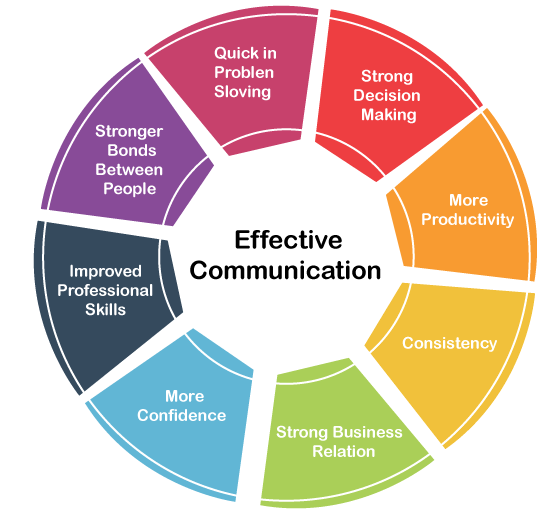
Improved Professional Skills: Effective communication skills help us to maintain better relationships with colleagues, creates a better team, and a positive environment to work. Stronger bonds between people: Effective communication helps create mutual understanding between people, leading to stronger bonds between them. Quick in Problem Solving: Effective communication focuses on listening skills, which helps people understand and analyze others' interests. Healthy decision making: Quick in problem-solving helps in effective decision making. More productivity: A healthy environment in the workspace leads to better performance, further increasing productivity. Consistency: Effective communication built teamwork, focus, and discipline between people, maintaining consistency. Strong Business Relations: Trust and loyalty define strong business relations, which are boosted by effective communication skills. More confidence: Effective communication with confidence is an essential skill. It helps us to stand for rights and values. MisconceptionCommunication vs. the English language is the common misconception in the mind of people. Good communication does not mean knowing the English language. Let's discuss it in detail. Most of us interpret that learning the English language means achieving good communication skills. But it is not correct. English is a skill, and communication is an art. Our communication can be pathetic even after learning the English language. We may not be able to speak when required due to hesitation or lack of confidence. Communication is an art that can be learned and developed, while language can only be learned. We need to first be perfect in our mother tongue. We should focus more on voice tone, postures, body language, maintaining eye contact, etc. We can learn English or any other language side by side. Barriers of CommunicationBarriers to communication are the obstacles that can distort a message reaching the receiver. Communication seems to be a simple process of exchanging views from the sender to the receiver. But, the channel or medium of communication plays a crucial role. The obstacle between our communications can be our emotions, culture, environment, distractions, lack of interest, unusual behavior, viewpoint, etc. 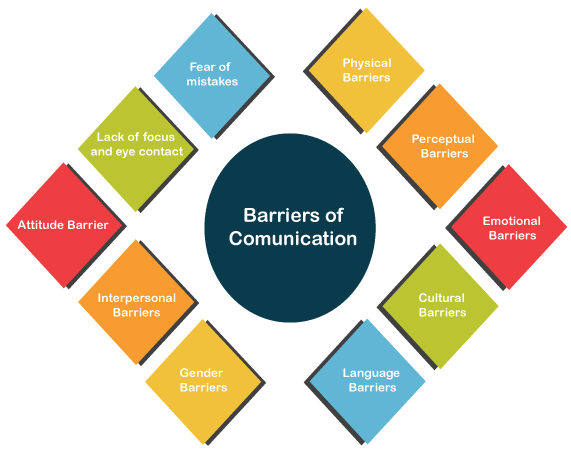
Let's discuss the barriers to effective communication in detail. Physical Barriers The physical barriers are the most common type of barriers in communication. It includes noise, closed doors, outdated equipment, etc. can cause frequent communication processes. We can overcome the physical barriers by finding the sources of noise or distraction and further removing it. Attitude Barriers The attitude barriers can arise due to individual habits, attitudes, overconfidence or behavior. Some problems, such as egoistic, shyness, anxiety, and fear, are within the individual's control and can be overcome by their own. But, selfishness, etc. might be difficult for individuals to correct themselves. Emotional Barriers The emotions in a person determine the ease and comfort in which he/she can communicate. Some people may face difficulty when their emotions overcome their conversation. But, a mature person can effectively communicate because he/she knows how to tackle emotions in such situations. For example, Some people suddenly laugh during a serious conversation. It may be due to remembering past situations or making fun of other people present in the conversation. So, control of emotions is essential for effective communication. Cultural Barriers Cultural barriers usually exit between countries, religions, caste, color, etc. at any level in society or an organization. These barriers can also occur between family or family members or groups. These behaviors represent the cultural sign between people. For example, nodding head means to agree to say yes. It may not be true everywhere. Hence, understanding cultural aspects is essential for communication all over the world. But due to globalization, cultural aspects are of great relevance today. Language Barriers The language barriers determine the difficulty of understanding the message between individuals or a group of people. It means that our language can become barriers if others do not understand our words, signs, or expressions. Such barriers include inappropriate words, jargon, difficult words, etc. Understanding such barriers is essential for effective communication in the public to develop good speaking skills. Gender Barriers The gender barriers mean the agenda for men and women. Some communication often has a fixed schedule. For example, some people think that women are more eager to conflict. The speech of men and women is also variant. A woman can speak up to 25000 words per day, while men can speak up to 10000 words per day. A woman speaks with mixed logic and emotions, while a man speaks with linear logic and straight. Lack of focus and eye contact Lack of focus and eye contact shows the disinterest of an individual in the communication. It not only distracts the mind of the speaker but also creates a negative impact. Fear of mistakes Mistakes often happen, and it is nothing to worry about. Instead, we should learn from our mistakes. Try to practice simple exercises to improve communication skills. It will also improve our confidence, language, and vocabulary. It also helps in recovering the mistakes. Psychological Barriers The psychological barriers define psychological and mental issues, such as depression, stage fear, phobia, poor health, etc. Sometimes, it becomes difficult to manage such situations. These barriers can be overcome by accepting imperfections, relaxation exercises, meditation, etc. Perceptual Barriers The perceptual barriers include the filters through which we view other people. The filters refer to personal values, expectations, attitudes, preferences, etc. Such barriers prevent us from making the correct perceptions about others. Keys of CommunicationCommunication is a simple process to present our views to others in different forms. Every individual has its ideas, feelings, thoughts, etc. to represent the information. But, it is essential to know the communication within us and the others. 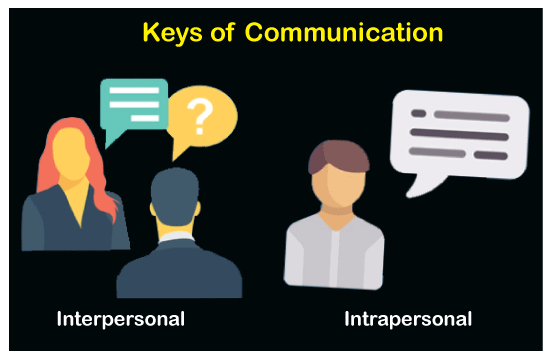
There are two keys to communication, which are listed below:
Interpersonal CommunicationInterpersonal communication is the communication between us and others over the channel. The communication can be online, face-to-face, video conference on mobile, etc. The type of communication (verbal, non-verbal, written, and visual) plays a crucial role in understanding others. We can send a formal message or the message that expresses our feelings. Some conversations also depict the relationships between people. Let's discuss some aspects of interpersonal communication, which are given below: Ethics It defines responsibility, behavior, cooperation between the two or more individuals. A relationship is not only about receiving, but also about giving. Emotions Emotions should not overtake the communication process. Hence, emotions are often noticed. Non- verbal The communication always focuses on the spoken words and the physical tone of the words. Context It is an integral part of communication, which can be relational and situational. Complex The misunderstandings are a common part of the communication. If misunderstandings are not cleared with time, it can make the process even more complicated. Irreversible It means that something written, spoken, expressed, etc. cannot be reverted. So, we should think before expressing our views to anyone. Intrapersonal CommunicationIntrapersonal communication is communication within us. It is also called as internal communication. It includes self-thinking, analysis, thoughts, assessments, etc. associated with the inner state of mind. Let's discuss some aspects of intrapersonal communication, which are given below: Perception The perception signifies how people interpret the things around them. It also depends on the positive or negative thinking of a person, which can influence intrapersonal communication. Self-obsession It defines the state of happiness and interest in self, which is better for everyone. But, excessive self-obsession leads to fooling our self. Concept The self-concept in the communication process includes one's own belief, attitude, values, and overcoming ourselves from a situation. Expectation It signifies our expectations for any task. We can fulfill our expectations with enthusiasm and confidence. Stage fear It is the fear of speaking in front of the public. Such fear can be overcome only by self. Interpersonal vs. IntrapersonalLet's discuss some differences between Interpersonal and Intrapersonal Communication.
Communication ModelThe communication models are the systematic representation of the communication process. The first model was introduced for Bell Laborites in 1949. The first model consists of the sender, channel and receiver. It was the telephone model, where the sender was the person who speaks, the telephone was the channel, and the receiver was the other person who could hear the sender's voice. The model was developed by Claude Shannon and Warren Weaver, who also discovered noise that causes interference in the received signal. Let's discuss the elements of the model, which are given below: An Information source It acts as a message source.
Communication is also defined as the exchange of information with the use of signs and symbols. The communication noise can interfere with the signal causing inaccurate results. Due to this, filters are inserted between the communication models, which filter out the channel's noise for effective communication. NoiseThe reason that causes interference in the decoding message or any communication process is termed as noise. Different types of noise can occur in any communication model. It is listed below:
Family CommunicationFamily communication is the study of communication with trust and understanding. It is essential because it allows the family members to express their feelings, needs, and concerns. The exchange of information can be in the form of verbal and non-verbal communication. Let's discuss some aspects of family communication, which are listed below:
Political CommunicationPolitical communication explains how information spread impacts politics, media, citizens, and policymakers. It includes the study of media and the speeches by various politicians, which impacts the political aspects. It also includes formal and informal communication between the public. 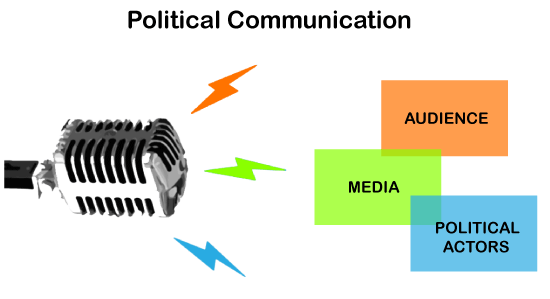
The media act as a link between the public and the government; The exchange of information can be verbal, written, and visual communication. Business CommunicationIt is a process of sharing information within the company and the outside world. It explains how employees and management of an organization work together to achieve a goal with minimum errors. Business communication is used for different activities, such as speed writing, meetings, client-customer relation, public relations, media relations, communication with employees, and planning. The range of communication can vary from small to large companies. A business professional's essential qualifications should be excellent communication skills, good writing, strategic, and critical thinking. Non-human CommunicationThe information exchange occurs between all living organisms, such as animals, plants, and microorganisms. It includes cellular transmission, chemical processes, etc.; Different living organisms have different forms of communication. Let's discuss the communication of plants, animals, and microorganisms in detail. PlantsThe communication can be observed within the plants of the same or different species. The major part of the communication of the plants is the root zone. The roots of the plants communicate with the microorganisms and insects present within the soil. It means that the plant uses roots to communicate with their neighbors. It is also said that the trees share their needs and nutrients via the lattice fungi buried in the soil. AnimalsThe behavior of an animal in communication affects the present and future behavior of the other animal. Zoosemiotics is defined as the study of animal communication. It has played an essential role in the development of animal cognition. The animal uses different forms of communication, such as auditory, visual, chemical, and tactile. The common communication method for animals is called telepathy, which can understand someone's feelings and minds. They communicate mentally with others. MicroorganismsFungi can communicate with its same and relates species. It can also communicate with non-fungal organisms, such as bacteria, insects, plants, through the biochemical process. The biochemicals are of biotic origin that triggers the reaction, but it does not trigger if the chemical molecules are not the part of the biotic process. The chemical signal molecule is the process used by microorganisms to communicate.
Next TopicUdemy vs. Udacity
|
 For Videos Join Our Youtube Channel: Join Now
For Videos Join Our Youtube Channel: Join Now
Feedback
- Send your Feedback to [email protected]
Help Others, Please Share









